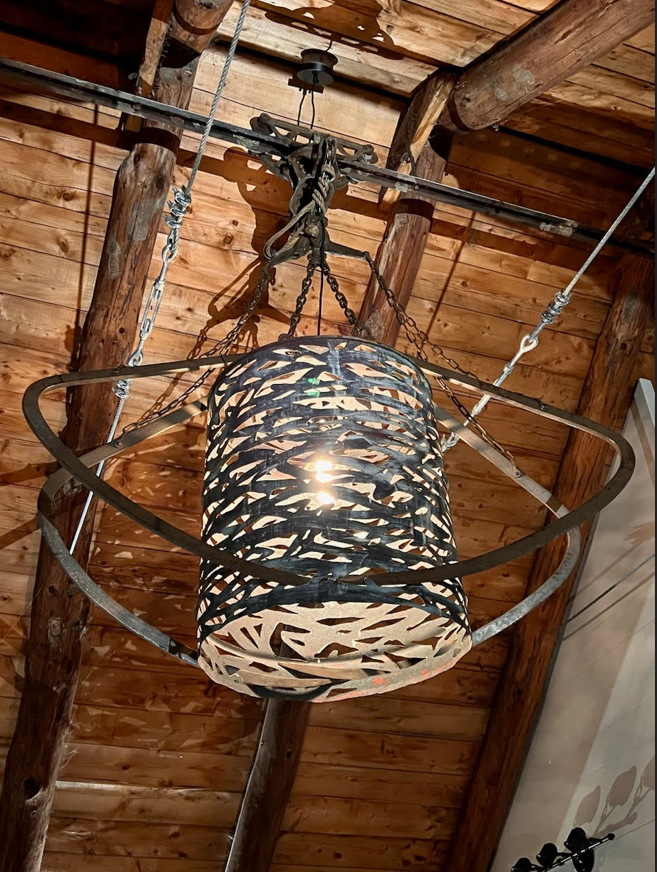When our 100-year old horse stable was initially built, it had a full second floor for hay storage. The peak of the ceiling houses a metal rail with a trolley that has a device made of four large claws or hooks called a grapple. The rail would extend out the large doors in the peak at the end of the barn, some six feet past the façade. The trolley would move along the rail, out the doors, and the grapple would be lowered to grab a hay bale, hoist it up, and retreat with it back inside to drop it in the second floor for storage.

In converting this horse stable into our home, I wanted to leave the rail, trolley, and grapple intact as testimony to the original function of the stable but I also wanted to give it a new purpose. The reimagined second floor was where the guest rooms were to be located, along with a mezzanine loft (created by removing nearly half of the second-floor plate) with a sofa, our family heirloom piano, and a table for games and puzzles. At some point during the renovation process, I happened to be on Instagram and saw a post by a talented metal artist/fabricator named Garrett Gilbart (@garrett.gilbart) showing an old car hood with an intricate scrollwork design cut-out.

Browsing through his body of work gave me an idea. I sketched up a rough drawing of a round, stylized, hay bale with a light hanging in the middle of it that would be held by the grapple claws of the trolley. I contacted Garrett and sent him my sketch. We exchanged many emails discussing the size of the light fixture, how much should be cut away, paint colours, and types of patina.

Garrett found an old metal drum that he cut down in length, and I drove the grapple up to his workshop, where his incredible magic began. Meanwhile, my electrician and I nailed down the details of up-lighting the ceiling, which would complement the feature light that Garrett was busy crafting. This light fixture now hangs over my puzzle and games table in the mezzanine, and aside from providing light on the table, the shadows cast through the “hay bale” and the trolley and grapple mechanisms onto the rafters are exquisite.
Another light!
Another area requiring a light fixture was the ceiling of the space underneath the mezzanine, which would be our dining room, opening into the double height great room over which the mezzanine looks.
The light would illuminate the old pine dining table made in 1996 by my husband from the 20 inch wide boards that were salvaged from the back of our 1888 century home in Stouffville, ON, while we were preparing for an addition. The table is 9 ½ feet long and I felt the light should also be very long.
I searched all of my lighting suppliers and couldn’t find anything suitable. The fixtures were either too typical, too chunky, too large in scale, or just didn’t suit the décor. I was getting quite discouraged when I came across an old black iron ladder that I had found in our shed near the barn and ear-marked for another purpose.
It weighed a ton and appeared to be the type of ladder you would typically find attached vertically to the outside of a silo, but smaller. I suspect it had been attached to the interior barn wall to climb up into the second-floor hayloft through a hatch.

My first idea for repurposing this ladder had been to suspend it horizontally from a beam in the kitchen area to render it as a pot hanging rack, but the location of the beams was such that that wouldn’t have worked. So, I talked to my builder about attaching the ladder to the dining area ceiling, running it the length of the dining table. Then, for $25 each from Home Depot, I purchased five small black light fixtures with clear glass shades to shine through the ladder rungs. Voilà!
An affordable and unique light fixture that can be decorated with seasonal garlands or left as is. The black iron looks great with the black trim of the windows and doors, and creates a striking contrast against the ceiling, which, resonating with the story of the table below it, is clad in the barn’s original interior wallboards, planed down a bit to better reveal their grain and patina.
So, there you have it – Salvaging and Repurposing, Part 2 of 4
Conclusion:
There, now you have Part II of a Salvaging and Repurposing series. I still have a few more to share, and by all means, let me know if you have a special item that you have salvaged and not sent to the landfill.
By Kim (Bo) Stone Kalil
Kim (nicknamed Bo in high school) Stone Kalil, lives in Toronto and spends as much time as possible with her family and friends at her home in the Thousand Islands, which was previously a 100-year-old defunct horse stable. Her design company is kskdesign.ca and she designed the home with the help of architectural designer Michael Preston out of Kingston, and had many design conversations with her son Matthew Kalil a Master of Architecture graduate of University of Toronto. The extensive renovation was done during 2020-2023 by the incredible Brian Wooding from Gananoque and his talented team. Bo is an avid traveller and photographer, and dabbles in acrylic painting. and as if that does not keep her busy enough, Bo is pursuing a degree in psychology part-time at York University in Toronto.
Be sure to see Thousand Islands Life, Salvaging and Repurposing, Part I, Volume 19, Issue 8, August 2024.


Posted in: Volume 19, Issue 9, September 2024, Architecture, Essay, Places, Current
Please click here if you are unable to post your comment.
